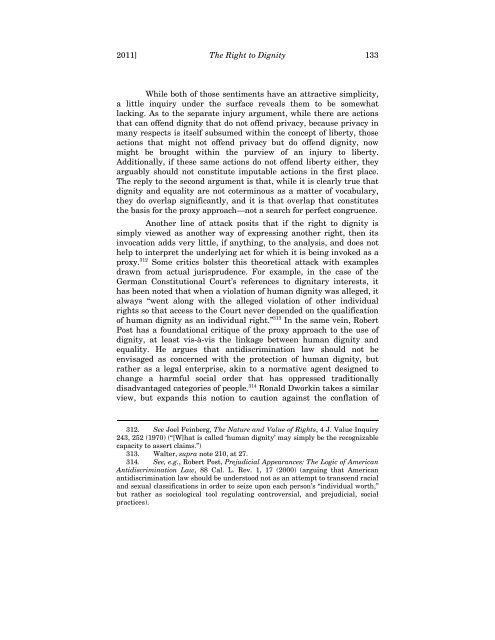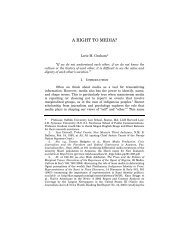The Right to Dignity Rex D. Glensy - Columbia Law School
The Right to Dignity Rex D. Glensy - Columbia Law School
The Right to Dignity Rex D. Glensy - Columbia Law School
Create successful ePaper yourself
Turn your PDF publications into a flip-book with our unique Google optimized e-Paper software.
2011] <strong>The</strong> <strong>Right</strong> <strong>to</strong> <strong>Dignity</strong> 133<br />
While both of those sentiments have an attractive simplicity,<br />
a little inquiry under the surface reveals them <strong>to</strong> be somewhat<br />
lacking. As <strong>to</strong> the separate injury argument, while there are actions<br />
that can offend dignity that do not offend privacy, because privacy in<br />
many respects is itself subsumed within the concept of liberty, those<br />
actions that might not offend privacy but do offend dignity, now<br />
might be brought within the purview of an injury <strong>to</strong> liberty.<br />
Additionally, if these same actions do not offend liberty either, they<br />
arguably should not constitute imputable actions in the first place.<br />
<strong>The</strong> reply <strong>to</strong> the second argument is that, while it is clearly true that<br />
dignity and equality are not coterminous as a matter of vocabulary,<br />
they do overlap significantly, and it is that overlap that constitutes<br />
the basis for the proxy approach—not a search for perfect congruence.<br />
Another line of attack posits that if the right <strong>to</strong> dignity is<br />
simply viewed as another way of expressing another right, then its<br />
invocation adds very little, if anything, <strong>to</strong> the analysis, and does not<br />
help <strong>to</strong> interpret the underlying act for which it is being invoked as a<br />
proxy. 312 Some critics bolster this theoretical attack with examples<br />
drawn from actual jurisprudence. For example, in the case of the<br />
German Constitutional Court’s references <strong>to</strong> dignitary interests, it<br />
has been noted that when a violation of human dignity was alleged, it<br />
always “went along with the alleged violation of other individual<br />
rights so that access <strong>to</strong> the Court never depended on the qualification<br />
of human dignity as an individual right.” 313 In the same vein, Robert<br />
Post has a foundational critique of the proxy approach <strong>to</strong> the use of<br />
dignity, at least visàvis the linkage between human dignity and<br />
equality. He argues that antidiscrimination law should not be<br />
envisaged as concerned with the protection of human dignity, but<br />
rather as a legal enterprise, akin <strong>to</strong> a normative agent designed <strong>to</strong><br />
change a harmful social order that has oppressed traditionally<br />
disadvantaged categories of people. 314 Ronald Dworkin takes a similar<br />
view, but expands this notion <strong>to</strong> caution against the conflation of<br />
312. See Joel Feinberg, <strong>The</strong> Nature and Value of <strong>Right</strong>s, 4 J. Value Inquiry<br />
243, 252 (1970) (“[W]hat is called ‘human dignity’ may simply be the recognizable<br />
capacity <strong>to</strong> assert claims.”)<br />
313. Walter, supra note 210, at 27.<br />
314. See, e.g., Robert Post, Prejudicial Appearances: <strong>The</strong> Logic of American<br />
Antidiscrimination <strong>Law</strong>, 88 Cal. L. Rev. 1, 17 (2000) (arguing that American<br />
antidiscrimination law should be unders<strong>to</strong>od not as an attempt <strong>to</strong> transcend racial<br />
and sexual classifications in order <strong>to</strong> seize upon each person’s “individual worth,”<br />
but rather as sociological <strong>to</strong>ol regulating controversial, and prejudicial, social<br />
practices).















